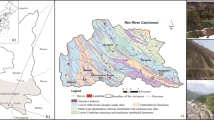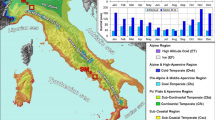Abstract
Landslides are mainly triggered by decrease in the matric suction with deepening the wetting band by rainfall infiltrations. This paper reports rainfall-induced landslides in partially saturated soil slopes through a field study. A comprehensive analysis on Umyeonsan (Mt.) landslides in 2011 was highlighted. The incident involves the collapse of unsaturated soil slopes under extreme-rainfall event. Fundamental studies on the mechanism and the cause of landslides were carried out. A number of technical findings are of interest, including the failure mechanism of a depth of soil and effect of groundwater flow, the downward movement of wetting band and the increase of groundwater level. Based on this, an integrated analysis methodology for a rainfall-induced landslide is proposed in this paper that incorporates the field matric suction for obtaining hydraulic parameters of unsaturated soil. The field matric suction is shown to govern the rate of change in the water infiltration for the landslide analysis with respect to an antecedent rainfall. Special attention was given to a one-dimensional infiltration model to determine the wetting band depth in the absence of the field matric suction. The results indicate that landslide activities were primarily dependent on rainfall infiltration, soil properties, slope geometries, vegetation, and groundwater table positions. The proposed methodology has clearly demonstrated both shallow and deep-seated landslides and shows good agreement with the results of landslide investigations.



















Similar content being viewed by others
References
Bowel JE (1997) Foundation analysis and design, 5th edn. McGraw-Hill, Singapore
Brinkgreve R, Swolfs W, Engin E (2010) Plaxis User’s Manual. Plaxis, Delft, The Netherlands
Caine N (1980) The rainfall intensity: duration control of shallow landslides and debris flows. Geogr Ann A 62:23–27
Calcaterra D, Santo A (2004) The January 10, 1997 Pozzano landslide, Sorrento Peninsula, Italy. Eng Geol 75(2):181–200
Capra L, Lugo-Hubp J, Borselli L (2003) Mass movement in tropical volcanic terrains: the case of Teziutlan. Eng Geol 69:357–379
Cascini L, Cuomo S, Pastor M, Sorbino G (2010) Modeling of rainfall-induce shallow landslides of the flow-type. J Geotech Geoenviron Eng 136(1):85–98
Chen CY, Chen TC, Yu FC, Yu WH, Tseng CC (2005) Rainfall duration and debris-flow initiated studies for real-time monitoring. Environ Geol 47:715–724
Da Costa A, Sagaseta C (2010) Analysis of shallow instabilities in soil slopes reinforced with nailed steel wire meshes. Eng Geol 113(1–4):53–61
Dahal RK, Hasegawa S, Nonomura A, Yamanaka M, Masuda T, Nishino K (2008) GIS-based weights-of-evidence modelling of rainfall-induced landslides in small catchments for landslide susceptibility mapping. Environ Geol 54(2):311–324
Ekanayake JC, Phillps CJ (2002) Slope stability thresholds for vegetated hill slopes: a composite model. Can Geotech J 39:849–862
Ellen SD, Fleming RW (1987) Mobilization of debris flows form soil slips, San Francisco Bay Region, California. Rev Eng Geol 7:31–40
Fourie AB, Rowe D, Blight GE (1999) The effect of infiltration on the stability of the slopes of a dry ash dump. Geotechnique 49(1):1–13
Fredlund DG, Rahardjo H, Fredlund H (2012) Unsaturated soil mechanics in engineering practice. Wiley, Hoboken
Fuchu D, Lee CF, Sijing W (1999) Analysis of rainstorm-induced slide-debris flows on natural terrain of Lantau Island, Hong Kong”. Eng Geol 51:279–290
Gasmo J, Hritzuk KJ, Rahardjo H, Leong EC (1999) Instrumentation of an unsaturated residual soil slope. Geotech Test J 22(2):128–137
GEO-SLOPE (2012) User’s manual. Geo-Slope International Ltd, Alberta
Godt JW, Coe JA (2007) Alpine debris flows triggered by a 28 July 1999 thunderstorm in the central Front Range Colorado. Geomorphology 84:80–97
Guzzetti F, Peruccacci S, Rossi M, Stark CP (2008) The rainfall intensity–duration control of shallow landslides and debris flows: an update”. Landslides 5(1):3–17
Hong M, Kim J, Jeong S (2017) Rainfall intensity-duration thresholds for landslide prediction in South Korea by considering the effects of antecedent rainfall. Landslides 1–12
Hungr O, Evans SG, Bovis MJ, Hutchinson JN (2001) A review of the classification of landslides of the flow type. Environ Eng Geosci 7(1):221–238
Innes JL (1983) Debris flows. Progr Phys Geogr 7(4):469–501
Iverson RM (2000) Landslide triggering by rain infiltration. Water Resour Res 36(7):1897–1910
Iverson RM (2003) The debris-flow rheology myth. Debris Flow Hazards Mitig Mech Predict Assess 1:303–314
Jeong S, Kim J, Lee K (2008) Effect of clay content on well-graded sands due to infiltration. Eng Geol 102:74–81
Kim YM, Jeong S (2017) Modeling of shallow landslides in an unsaturated soil slope using a coupled model. Geomech Eng 13(2):353–370
Kim J, Jeong S, Park S, Sharma J (2004) Influence of rainfall-induced wetting on the stability of slopes in weathered soils. Eng Geol 75:251–262
Kim J, Jeong S, Regueiro RA (2012) Instability of partially saturated soil slopes due to alteration of rainfall pattern. Eng Geol 147:28–36
Kim J, Lee K, Jeong S, Kim G (2014) GIS-based prediction method of landslide susceptibility using a rainfall infiltration-groundwater flow model. Eng Geol 182:63–78
Kim YM, Jeong S, Kim J (2016) Coupled infiltration model of unsaturated porous media for steady rainfall. Soils and Found 56(6):1071–1081
Korea Forest Research Institute [KFRI] (2006) Survey manual for forest biomass. Forest Research Institute, Seoul, Korea 51 (in Korean)
Korean Geotechnical Society (KGS) (2012) Research contract report: addition and complement causes survey of Umyeonsan (Mt.) landslide
Le T, Bae DH (2013) Evaluating the utility of IPSS AR4 GCMs for hydrological application in South Korea. Water Resour Manag 27:3227–3246
Lee JY, Rhee JH, Oak YS, Koo HB (2012) Consideration of minimum safety factors for cut-slope infiltration analysis. J Eng Geol 22(4):375–385
Li AG, Yue ZQ, Tham LG, Lee CF, Law KT (2005) Field-monitored variations of soil moisture and matric suction in a saprolite slope. Can Geotech J 42(1):13–26
Lu N, Godt J (2008) Infinite slope stability under steady unsaturated seepage conditions. Water Resour Res 44:11
Lu N, Likos WJ (2004) Unsaturated soil mechanics. Wiley, Hoboken
Lu N, Wayllace A, Oh S (2013) Infiltration-induced seasonally reactivated instability of a highway embankment near the Eisenhower Tunnel, Colorado, USA. Eng Geol 162:22–32
Ng CWW, Shi Q (1998) A numerical investigation of the stability of unsaturated soil slopes subjected to transient seepage. Comput Geotech 22(1):1–28
Ng CWW, Zhan LT, Bao CG, Fredlund DG, Gong BW (2003) Performance of an unsaturated expansive soil slope subjected to artificial rainfall infiltration. Géotechnique 53:143–157
Ng CWW, Springman SM, Alonso EE (2008) Monitoring the performance of unsaturated soil slopes. Geotech Geol Eng 26:799–816
Nilaweera NS, Nutalaya P (1999) Role of tree roots in slope stabilization. Bull Eng Geol Env 57:337–342
Norris JE, Stokes A, Mickovski SB, Cammeraat E, van Beek R, Nicoll BC, Achim A (eds) (2008) Slope stability and erosion control: ecotechnological solutions. Springer
Park DW, Nikhil NV, Lee SR (2013) Landslide and debris flow susceptibility zonation using TRIGRS for the 2011 Seoul landslide event. Nat Hazards Earth Syst Sci 13:2833–2849
Pirone M, Papa R, Nicotera MV (2011) Test site experience on mechanisms triggering mudflows in unsaturated pyroclastic soils in southern Italy. In: Proceedings of the 5th international conference on unsaturated soils, Taylor & Francis, UK, vol 2, pp 1273–1278
Rahardjo H, Leong EC, Gasmo JM, Tang SK (1998) Assessment of rainfall effects on stability of residual soil slopes. In: Proceedings 2nd international conference on unsaturated soils, Beijing, China, vol 2, pp 280–285
Schmidt KM, Roering JJ, Stock JD, Dietrich WE, Montgomery DR, Schaub T (2001) The variability of root cohesion as an influence on shallow landslide susceptibility in the Oregon Coast Range. Can Geotech J 38(5):995–1024
Soilworks (2014) manual of utilisation. http://www.manual.midasuser.com. Accessed 22 Feb 2017
Sorbino G, Nicotera MV (2013) Unsaturated soil mechanics in rainfall-induced flow landslides. Eng Geol 165:105–132
Take WA, Bolton MD, Wong PCP, Yeung FJ (2004) Evaluation of landslide triggering mechanisms in model fill slopes. Landslides 1(3):173–184
Tiranti D, Bonetto S, Mandrone G (2008) Quantitative basin characterization to refine debris-flow triggering criteria and processes: an example from the Italian Western Alps. Landslides 5:45–57
Vanapalli SK, Fredlund DG, Pufahl DE, Clifton AW (1996) Model for the prediction of shear strength with respect to soil suction. Can Geotech J 33(3):379–392
Wang FW, Sassa K, Wang G (2002) Mechanism of a long-runout landslide triggered by the August 1998 heavy rainfall in Fukushima Prefecture, Japan. Eng Geol 63:169–185
Wu W, Sidle RC (1995) A distributed slope stability model for steep forested basins. Water Resour Res 31:2097–2110
Yang DQ, Rahardjo H, Leong EC, Choa V (1998) Coupled model for heat moisture air flow and deformation problems in unsaturated soils. J Eng Mech 124(12):1331–1338
Acknowledgements
The authors acknowledge support in this research from the National Research Foundation of Korea (NRF) (Grant No. 2011- 0030040).
Author information
Authors and Affiliations
Corresponding author
Rights and permissions
About this article
Cite this article
Kim, J., Kim, Y., Jeong, S. et al. Rainfall-induced landslides by deficit field matric suction in unsaturated soil slopes. Environ Earth Sci 76, 808 (2017). https://doi.org/10.1007/s12665-017-7127-2
Received:
Accepted:
Published:
DOI: https://doi.org/10.1007/s12665-017-7127-2




